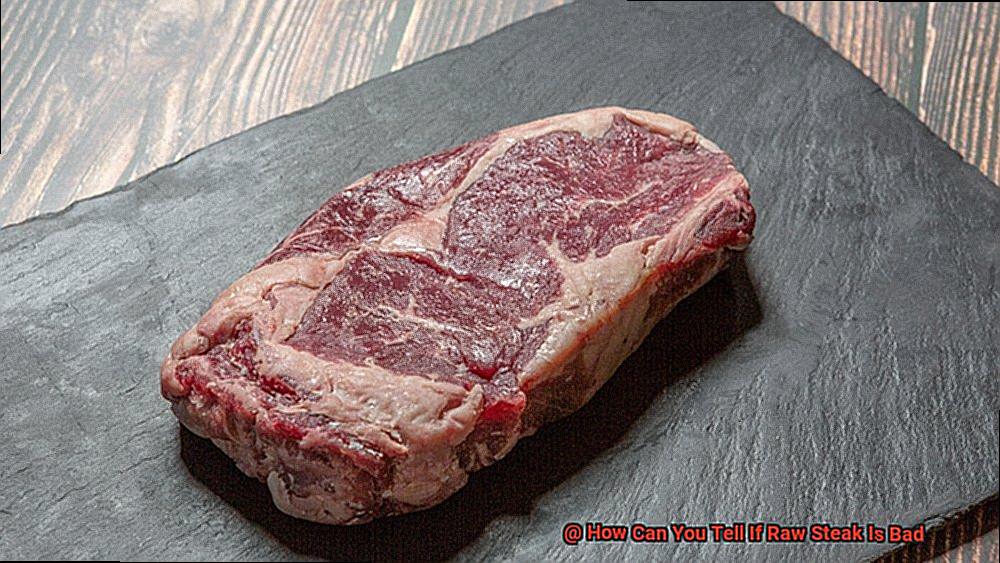Nothing sends chills down your spine like the reek of rotten meat. Whether you’re a grill master or simply a carnivorous enthusiast, sinking your teeth into a perfectly cooked, juicy steak is a moment of pure bliss. But what if you’ve accidentally brought home a batch of bad raw steak? The consequences could range from an unpleasant meal to potential foodborne illnesses.
But fret not, my fellow steak aficionados. In this tantalizing blog post, we’re about to unravel the secrets of identifying whether your raw steak has gone bad. From its appearance and texture to the all-important sniff test, we’ll arm you with the knowledge and tools needed to become a culinary detective.
Before we dive in, let’s highlight the main points we’ll explore:
- The Visual Clues: Fresh raw steak boasts a vibrant, cherry-red color that sets it apart. We’ll guide you through spotting any discoloration, excessive browning, or slimy film that may indicate spoilage.
- Tenderness and Texture: A good steak should be firm yet yielding. We’ll explain how to detect any unusual softness, sliminess, or excessive toughness that might hint at decomposition.
- The Aroma Audit: Trust your nose—it’s an essential tool in your steak-inspecting arsenal. We’ll explore the distinct odors of fresh steak versus spoiled meat, helping you differentiate between mouthwatering aromas and pungent foulness.
- Beyond ‘Best Before’: Understanding expiration dates, storage techniques, and packaging precautions will further safeguard you against consuming rotten raw steak.
Remember, an extraordinary culinary adventure hinges on the quality of ingredients chosen. By the end of this guide, you’ll be armed with the confidence to navigate the realm of raw steaks flawlessly—ensuring every dining experience is an exquisite triumph.
So, are you ready to embark on a sensory exploration where knowledge reigns supreme? Let’s sharpen our senses and uncover the truth about spoiled raw steak together.
Contents
What Does Fresh Raw Steak Smell Like?
Embark on a sensory journey as we unravel the tantalizing aroma of fresh raw steak. Delving into its depths, we’ll explore the nuances of scent that herald the promise of a delectable culinary experience. Join us as we navigate the fragrant landscape, uncovering the secrets behind the olfactory symphony that is fresh raw steak.
The Sensory Symphony:
As you bring a fresh raw steak to your nose, be prepared for a delicate metallic whiff, akin to a gentle kiss of iron. Far from repulsive, this subtle note is indeed an auspicious sign of quality. Complementing this is an earthy richness that envelops your senses, beckoning you to indulge in its succulent potential. For those with discerning noses, a hint of grassiness or gaminess may also dance in the air, particularly in grass-fed or game meats.
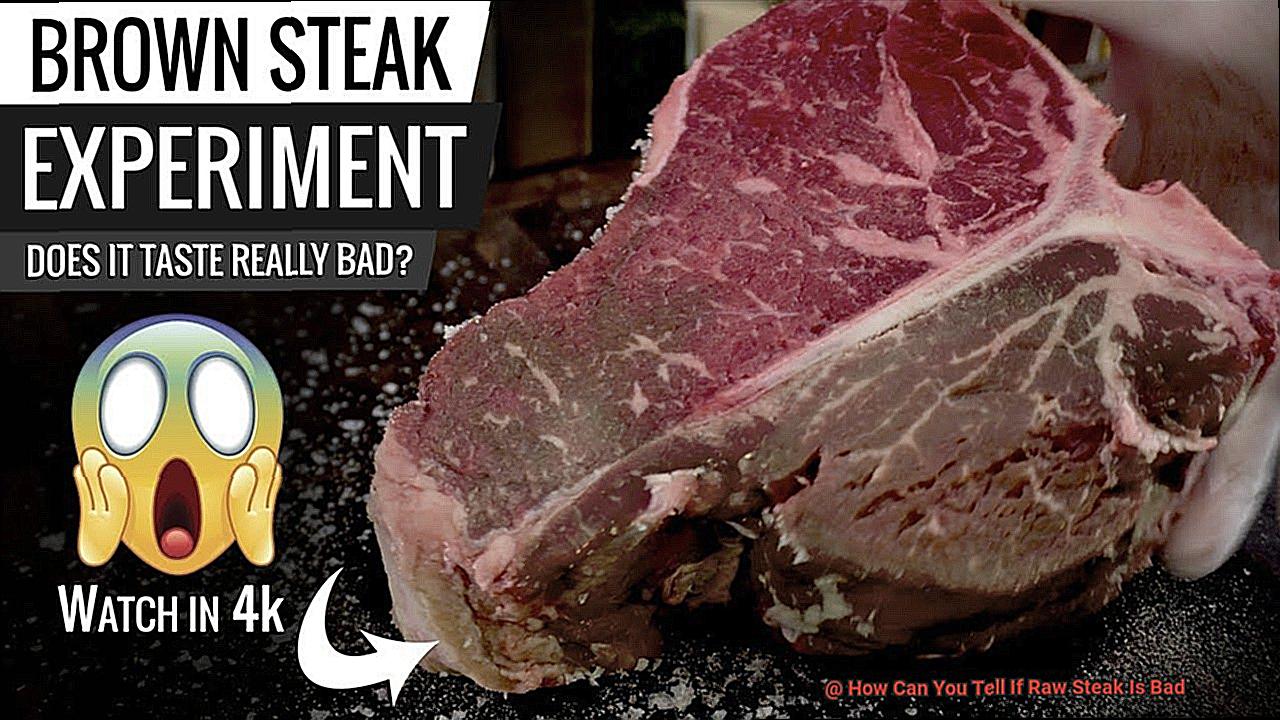
The Melody of Cut, Aging, and Marbling:
Each cut of steak possesses its own aromatic symphony, influenced by factors such as fat content, muscle composition, and aging techniques. Picture a marbled ribeye serenading your olfactory receptors with its sweet undertones, courtesy of the exquisite intramuscular fat distribution. Contrastingly, leaner cuts like filet mignon whisper a more subtle fragrance, inviting you to savor their understated elegance.
Harmonizing with Signs of Spoilage:
In our exploration of fresh raw steak’s olfactory realm, we must not neglect the dissonance that signals spoilage. Beware the pungent crescendo of a strong, sour, or ammonia-like smell; it signifies an irredeemably spoiled piece of meat that should be immediately discarded. Accompanying this discordant note may be discoloration in the form of gray or brown patches, excessive moisture, or a disconcerting sliminess. When doubt lingers, let your instincts guide you to safeguard your palate’s harmony.
Texture: A Tactile Symphony:
In our quest for culinary excellence, we must not overlook the importance of texture. A fresh raw steak should offer resistance to your touch, its firmness and gentle resilience harmonizing with the promise of succulence. However, should its texture yield too readily, embracing an unwelcome softness or mushiness, be wary of decomposition that may ensue.
How to Tell if the Color of Raw Steak is Bad
Are you ready to unravel the secrets of deciphering the color of raw steak? Look no further, as we embark on a journey to uncover the signs that indicate the freshness and quality of your beloved beef. Get ready to elevate your steak game with these expert tips.
The Radiant Red or Cherry-Red Color:
Prepare to be captivated by the sight of fresh, high-quality steak boasting a vibrant red or cherry-red color. This mesmerizing hue is an enchanting result of myoglobin, a protein that bestows meat with its crimson charm. When your eyes feast upon this vivid shade, rejoice, for it is a tantalizing clue that your steak is primed for culinary excellence.
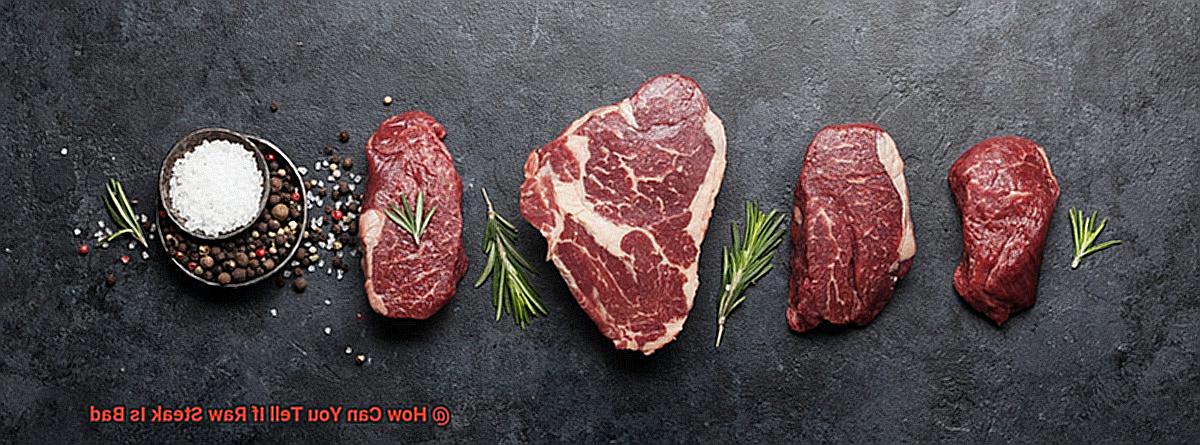
Browning or Gray Discoloration: A Warning Sign:
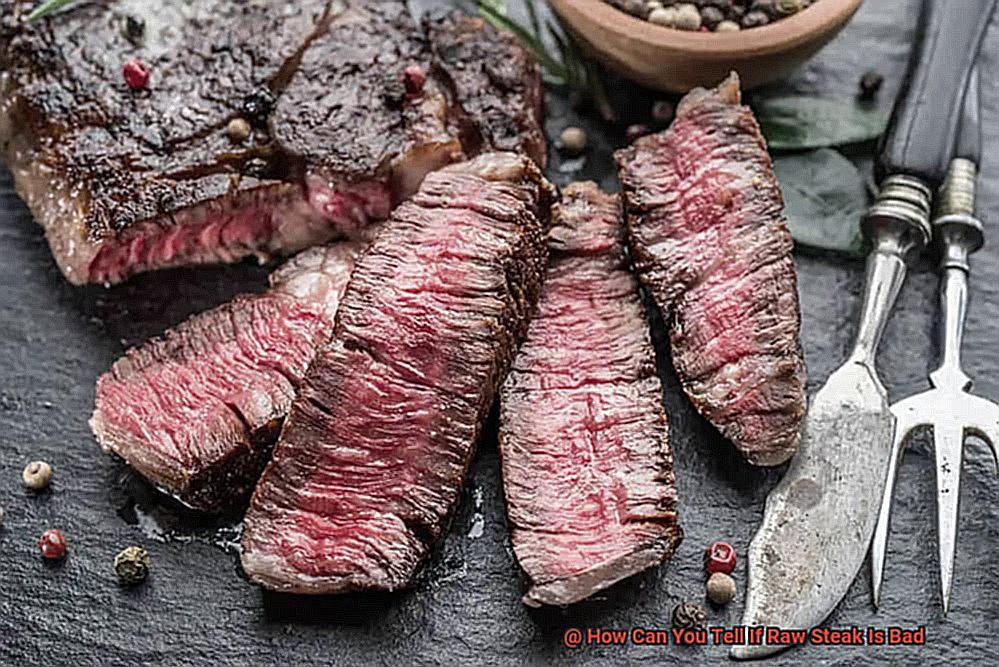
Amidst this symphony of red, be vigilant for any unwelcome guests in the form of discoloration. A dull brown or gray appearance is like a siren’s call, signaling that your meat may have embarked upon the treacherous path of spoilage.
These undesirable hues emerge as a consequence of oxidation and exposure to air, triggering myoglobin’s metamorphosis into a less appetizing shade. In the face of such unwelcome transformations, it is wise to bid adieu to the tainted steak and seek out a fresher alternative.
Green or Blue Spots: Nature’s Signal of Danger:
In your quest for culinary bliss, beware of nature’s warning signs manifested as green or blue spots on the surface of your raw steak. These peculiar pigments are ominous omens, heralding the presence of bacterial growth.
As bacteria flourish and propagate their vibrant palette on the meat’s canvas, they beckon you away from indulgence and towards potential foodborne perils. To protect yourself and your fellow steak enthusiasts, cast aside any cut adorned with these sinister shades.
Texture: A Touch of Freshness:
In the realm of steak evaluation, texture reigns supreme as an arbiter of freshness. A firm and slightly springy sensation beneath your fingertips is akin to the gentle whispers of a secret shared between you and your steak.
Picture the contrast between pressing down upon a soft sponge versus the resilient embrace of a plump pillow – that’s the tactile distinction that separates fresh meat from its spoiled brethren. Should you encounter excessive softness or a disconcerting mushiness, heed the warning, for decay may have begun to claim your steak.
Assessing Texture for Quality
We’ve already explored the captivating world of color and its connection to freshness and quality. Now, let’s embark on a tantalizing journey to unravel the secrets of texture.
From the firmness that beckons your touch to the mesmerizing marbling and the intricate muscle fibers, we’re about to dive deep into the realm of quality assessment.
So, grab your apron and get ready to discover the hidden treasures that lie within every cut of steak.
Assessing Texture for Quality: The Code Decoded
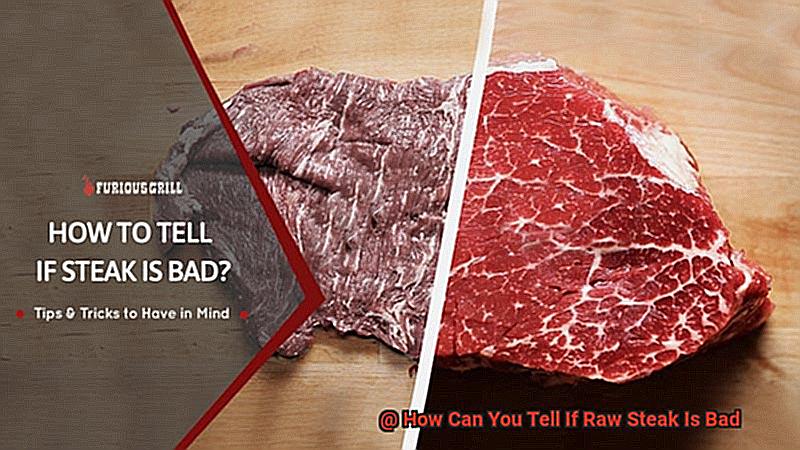
Firmness:
When you lay your hands on a raw piece of steak, pay attention to its firmness. A touch of firmness is a telltale sign of freshness. Picture gently pressing a stress ball—a slight give is all you need. But beware of soft or mushy textures; they signal an unwelcome journey towards spoilage. Say goodbye to those and save your taste buds from disappointment.
Marbling:
Now, let’s explore the delicate art of marbling—the secret sauce for flavor and tenderness. This luxurious phenomenon refers to those thin streaks of fat delicately woven through the muscle fibers. Quality steak boasts evenly distributed marbling that transforms into sheer ecstasy when cooked to perfection. However, be wary of excessive or uneven marbling; it may hint at inferior quality or an older piece of meat.
Color:
Ah, color—the visual symphony that whispers freshness into our ears. While the hues of raw steak may vary with cuts and types of meat, fresh cuts dance with vibrant shades of red or pink.
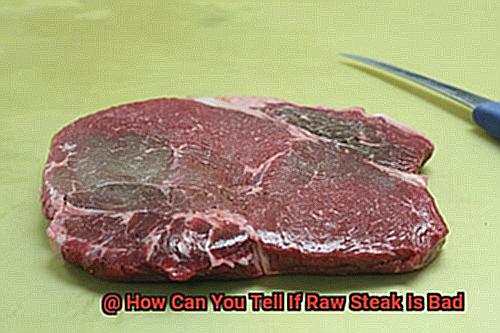
It’s nature’s way of saying, “This steak is top-notch.” But watch out for any grayish or brown discoloration lurking on the surface or within the meat. These unsightly shades are clear signals that the steak has passed its prime and should be left behind.
Muscle Fibers:
Zooming in on the mesmerizing tapestry of muscle fibers, we discover an intricate network that holds the key to succulence. High-quality steak boasts tightly packed and well-defined fibers, akin to a disciplined army ready to conquer your taste buds. But beware of any signs of separation or gaps between these soldiers; they may suggest mishandling or a lack of freshness.
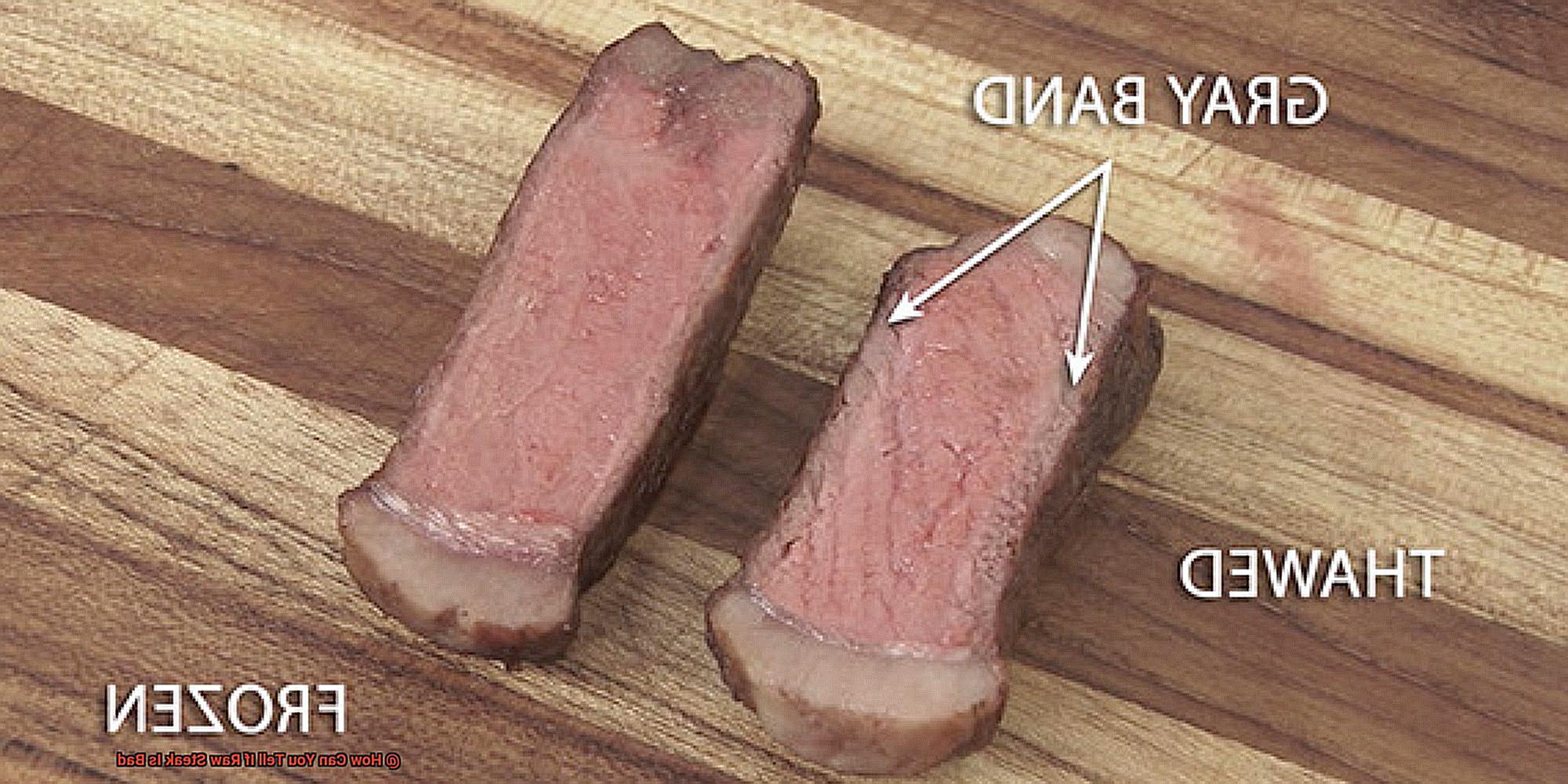
Examining Expiration Dates
Today, we embark on a journey into the captivating realm of expiration dates. I know, I know, it may not seem as thrilling as savoring a perfectly cooked steak, but trust me, understanding expiration dates can be the key to unlocking the utmost freshness and quality of your raw meat. So, let’s get right into it.
First and foremost, what exactly are expiration dates? Well, my friends, they are those tiny numbers delicately imprinted on the packaging that provide invaluable insight into when your steak should be consumed or utilized for optimal quality and safety. Think of them as your steak’s personal freshness guide, guiding you to culinary bliss.
Before even considering purchasing or using raw steak, it is absolutely imperative to check that expiration date. It is akin to unraveling a hidden code that holds the potential for either tantalizing deliciousness or potential disappointment lurking within. Paying attention to this seemingly minute detail ensures that you obtain the freshest steak imaginable.
Now, here’s the clincher: if that expiration date has already passed, don’t fret just yet. While it may not automatically render your steak inedible, it does indicate that its quality might have diminished. Let’s face it, we all want our steaks to consistently achieve peak perfection each time they grace our plates.
This is where things truly become intriguing. Different types of steaks possess varying shelf lives. Yes, you heard me correctly. That means you must scrutinize the specific expiration date for every type of steak nestled within your refrigerator. It’s a small sacrifice to make for a mouthwatering culinary experience.
Now, let’s delve into what transpires if you decide to play fast and loose with those expiration dates. If you have diligently stored your steak in ideal conditions and within its designated expiration date, chances are it remains safe for consumption. However, heed my advice and don’t push your luck. Should you detect any telltale signs of spoilage, such as an offensive odor, a slimy texture, or an abnormal color, it is best to part ways with that steak, my friend. No amount of seasoning can salvage it now.
Oh, and before we conclude, there’s one more aspect to consider. Proper storage and handling practices prove paramount in preserving the freshness and quality of your raw steak, even within its allotted expiration date. So, make certain to follow any additional instructions meticulously outlined on the packaging. Your taste buds will be eternally grateful.
The Importance of Combining Indicators
In the world of culinary exploration, determining the condition of raw steak is like deciphering a hidden message. By combining indicators, we can unravel the truth about its freshness and quality. In this article, we will delve into the importance of not relying on a single indicator and explore how a holistic approach using multiple indicators is essential in making informed decisions.
The Color Code
Color plays a crucial role in assessing raw steak. A vibrant, cherry-red hue signifies freshness. However, it’s vital to consider that some cuts, such as aged or vacuum-sealed ones, naturally appear darker. Discoloration in the form of brown or gray patches can be a telltale sign of spoilage. By considering color in conjunction with other indicators, we can paint a clearer picture of the steak’s true condition.
Texture Tales
The texture of raw steak is a treasure trove of information. A fresh steak should feel firm to the touch, indicating its prime state. However, if it feels mushy or slimy, bacterial growth and spoilage may be present.
Visible signs of mold or excessive moisture on the surface should never be overlooked. Combining these texture indicators with others provides valuable insights in determining whether to bid farewell to that steak.
Unleashing the Scent
Our sense of smell becomes an invaluable ally when evaluating raw steak. Fresh meat emits a faint metallic odor or no smell at all. However, if it releases a strong and unpleasant aroma resembling ammonia or sulfur, it is undoubtedly spoiled and unfit for consumption. By combining our sense of smell with other indicators, we can confirm our suspicions before cooking that steak.
The Date Dilemma
While not infallible, the expiration or “sell-by” date on the packaging serves as a helpful guideline. It provides an estimated period during which the meat should remain fresh when stored properly. However, relying solely on this date can lead to misjudgment. By combining it with other indicators, we gain a comprehensive understanding of the steak’s overall quality and safety.
Signs of Spoilage in Raw Steak
Imagine the excitement of preparing a delectable steak dinner, only to be plagued by doubt about the freshness of the raw meat. Fear not, my fellow steak enthusiasts. As a culinary expert, I am here to reveal the secrets behind identifying signs of spoilage in raw steak. So, sit back, relax, and let me guide you through the hidden code of steak freshness.
Color:
Let’s begin with the basics: color. A high-quality steak should boast a vibrant red hue that ignites your taste buds. However, beware of any unsightly gray or brown patches on the meat’s surface – these are clear signs that your steak is on its way out. And if it appears excessively pale or even sports a greenish tint, it’s best to steer clear.
Texture:
Ah, texture – the unsung hero of steak examination. Fresh meat should offer a firm touch and a slight moistness on its surface. But beware. If your fingers encounter a slimy or sticky sensation, it’s a clear indication that your steak has gone off. And please, avoid any unpleasant surprises like mold or strange growths – they’re definite no-nos.
Odor:
Now let’s sniff out another telltale sign – odor. A fresh steak should have a neutral or slightly metallic scent, whispering promises of a mouthwatering feast. However, if you catch a whiff of anything strong or unpleasant emanating from your meat, it’s time to sound the spoilage alarm. A sour or ammonia-like smell might indicate bacterial growth while a putrid or rotten odor is an unmistakable sign of advanced spoilage. Trust your nose on this one.
Marbling:
Here’s where things get interesting – marbling. This beautiful intermingling of fat and muscle fibers adds flavor and tenderness to your steak. But beware excessive marbling – it can be a red flag. If you notice an abnormal amount of fat streaks in your meat, it could mean that your steak has overstayed its welcome in the freshness department. Don’t be afraid to bid farewell and move on to a better cut.
Expiration Date:
Last but not least, always check the expiration date on the packaging when purchasing raw steak. Even if there are no visible signs of spoilage, an expired steak may still pose health risks. So, err on the side of caution and avoid consuming it.
Safety Tips when Evaluating Raw Steak
When it comes to evaluating raw steak, prioritizing food safety is paramount. Understanding how to determine the freshness and safety of the meat is crucial to prevent foodborne illnesses. By following these safety tips, you can confidently assess the quality of raw steak and minimize any risks.
Purchase from trusted sources:
To ensure the safety of raw steak, always buy from reputable butchers or grocery stores known for their high-quality meat. These sources adhere to strict standards for handling and storing meat, reducing the risk of contamination. Avoid purchasing from establishments that do not meet proper hygiene standards or have questionable practices.
Check packaging dates:
Take note of the sell-by or use-by dates on the packaging. These dates serve as guidelines for when the steak was initially packaged. Consuming expired raw steak can be dangerous and significantly increase the risk of food poisoning. Opt for steaks with longer shelf lives to ensure maximum freshness.
Assess appearance:
Before purchasing or cooking raw steak, carefully inspect its appearance. Fresh raw steak should exhibit a vibrant red color, indicating its good condition. Discard steaks that show signs of gray or brown discoloration, as this may be an indication of spoilage. Additionally, be vigilant for any unusual spots or blemishes on the surface of the meat.
Evaluate texture:
The texture of raw steak is another crucial factor in determining its freshness. When touched, the meat should feel firm and slightly springy. Any mushiness or excessive softness may suggest that the meat has started to decompose. A high-quality piece of raw steak should have a pleasing texture.
Trust your olfactory senses:
Your sense of smell is a powerful tool when evaluating raw steak. Fresh raw steak should emit a mild, slightly metallic odor or even a faint sweet aroma. However, if you detect a strong, foul, or sour smell, it is likely spoiled and should not be consumed. Trust your senses when assessing the smell of raw steak.
Common Causes of Spoiled Meat
Today, we embark on a flavorful journey to uncover the secrets behind spoiled meat. Why is this expedition important, you ask? Well, aside from the obvious distaste of biting into rotten steak, spoiled meat can jeopardize your health. So, let’s sharpen our detective skills and unravel the mysteries of preserving the delectable essence of our precious steaks.
Bacterial Growth – The Ultimate Villain:
Imagine this: your juicy steak basking in the open air, an invitation for trouble. This scenario is a breeding ground for bacterial growth, and trust me, you don’t want these unwelcome guests crashing your dining experience. Bacteria such as Salmonella and E. coli can transform your mouthwatering steak into a recipe for food poisoning if consumed.
Temperature Control – Keep It Cool:
Remember, your steak craves coolness. Maintaining a temperature below 40°F (4°C) is crucial in preventing bacterial growth. Allowing it to linger at room temperature is akin to rolling out the red carpet for those pesky bacteria. So, be ever watchful and store your meat in the chilly embrace of the refrigerator.
Proper Storage – Lock in the Freshness:
To shield your steak from spoiling, employ your trusty tools: airtight containers or snug wrapping with plastic wrap or foil. These protective layers keep air out and minimize the risk of bacterial contamination. Oh, and don’t forget to keep raw steak separate from ready-to-eat foods – we want to avoid any cross-contamination drama.
Improper Handling Practices – The Sneaky Culprit:
Sometimes, it’s not just what happens after you bring your steak home but how you handle it that can lead to disaster. Neglecting to wash your hands thoroughly before handling raw meat, using unclean utensils or cutting boards, or employing expired marinades or spices can introduce harmful bacteria to your once-pristine steak. Let’s maintain cleanliness and freshness from start to finish.
You’ve successfully unraveled the common causes of spoiled meat and discovered ways to prevent them. By comprehending the role of bacterial growth, temperature control, proper storage, and safe handling practices, you can savor a delicious and safe steak.
WOrDQEAFFgQ” >
Conclusion
Determining whether raw steak is spoiled is crucial for ensuring food safety.
By using your senses, you can easily detect signs of spoilage. Look out for a foul odor emanating from the meat.
If it smells rotten or putrid, discard it immediately. Additionally, inspect the color and texture of the steak.
Trust your instincts—if something seems off, don’t take any chances with your health.

